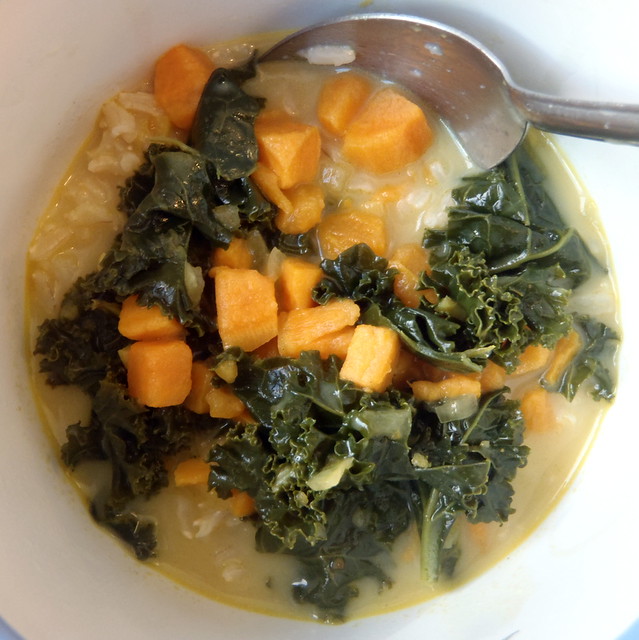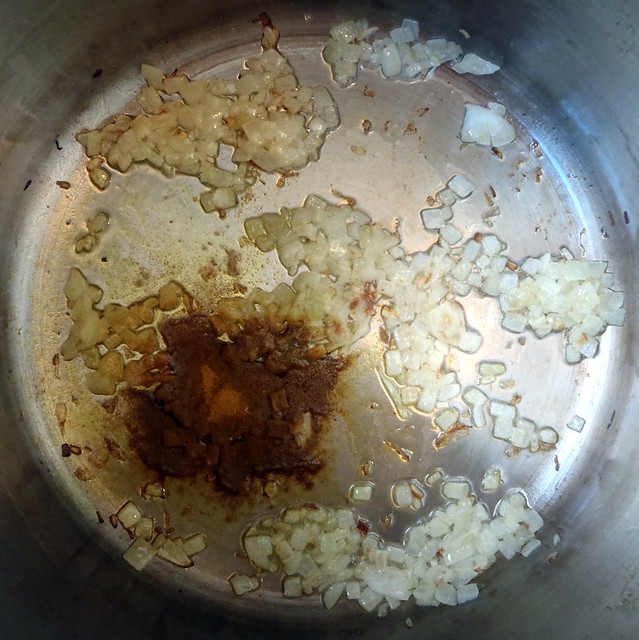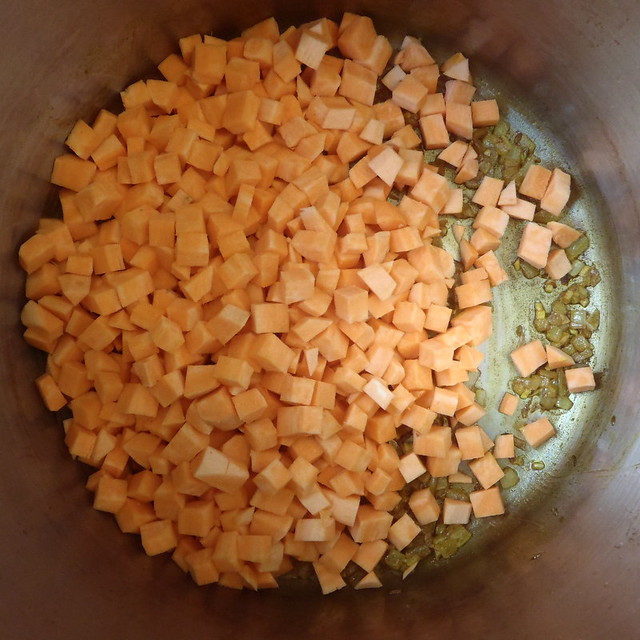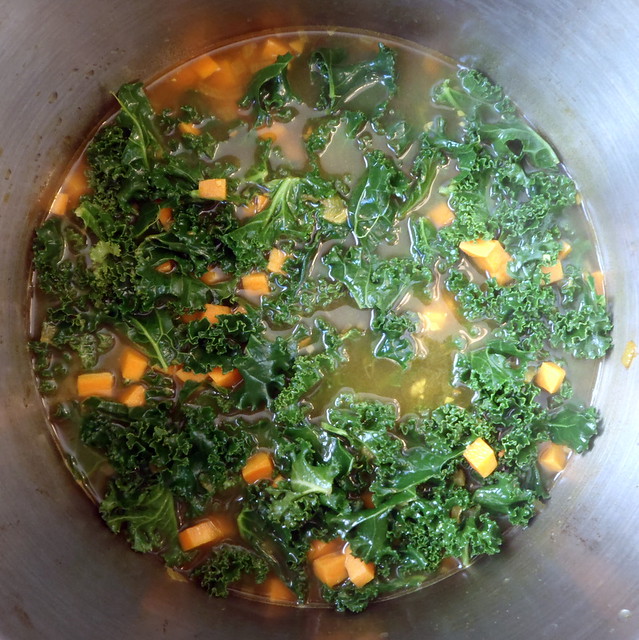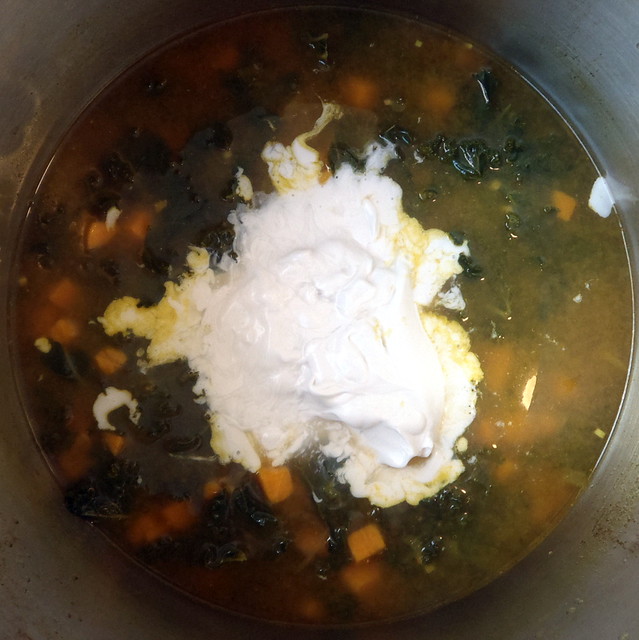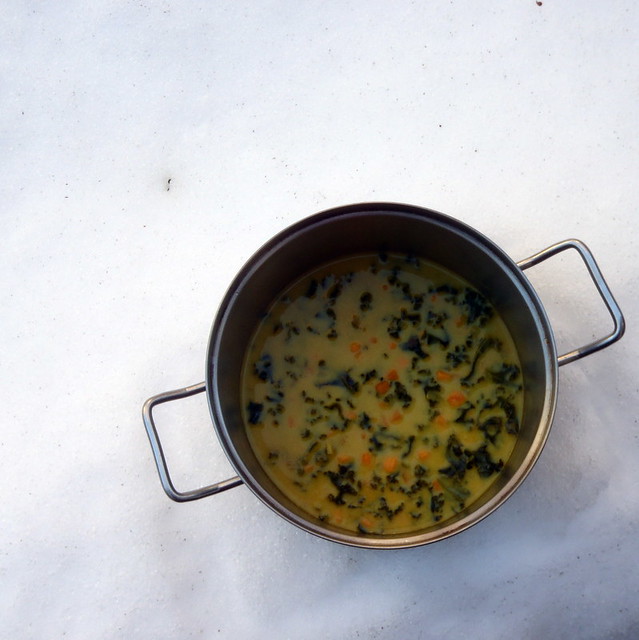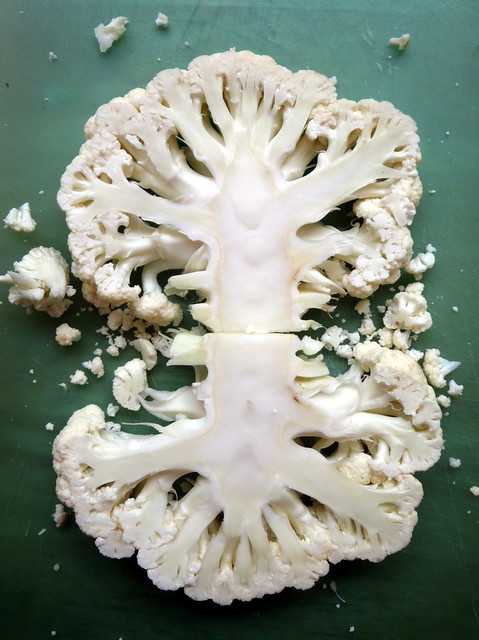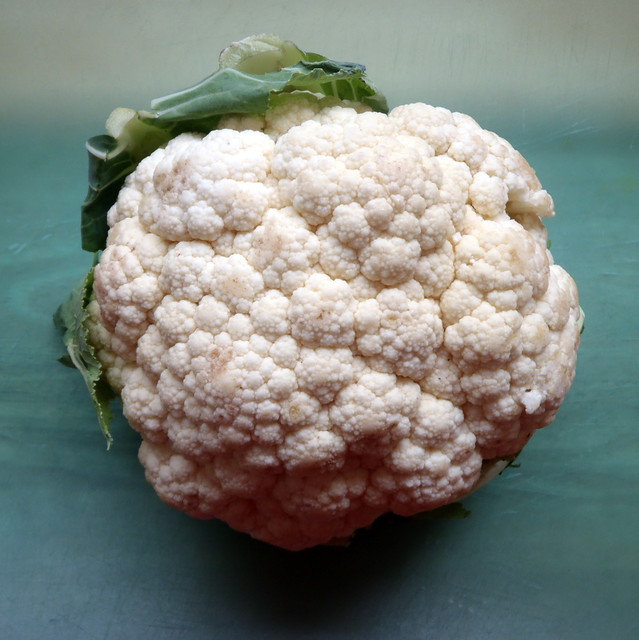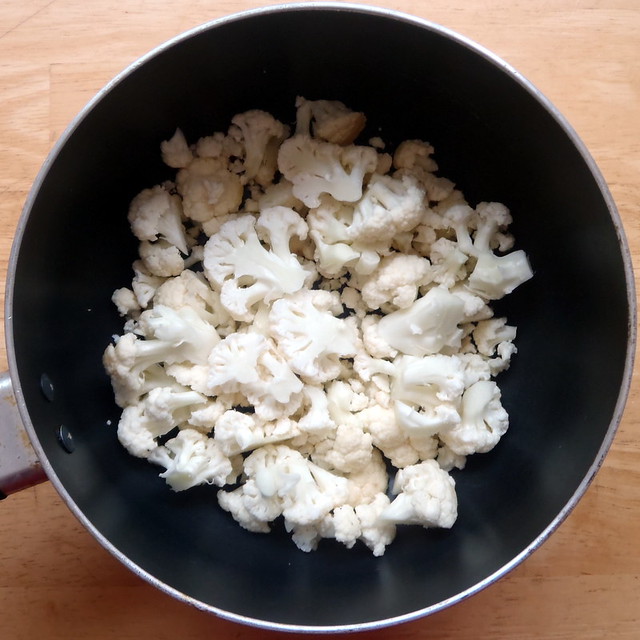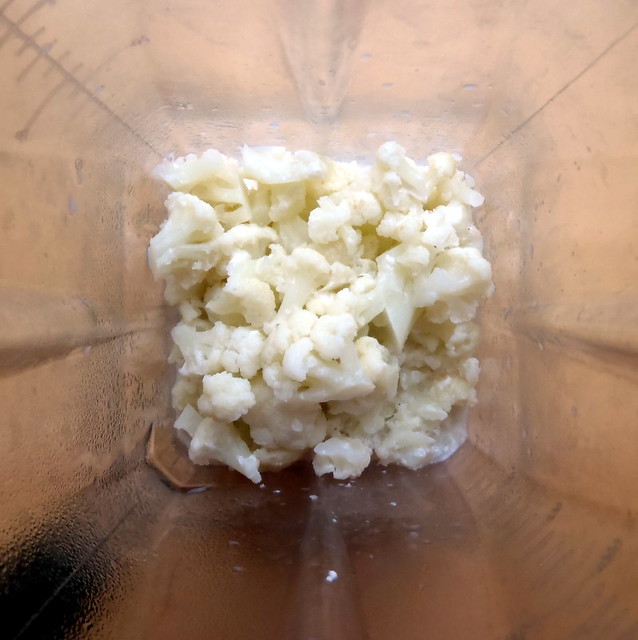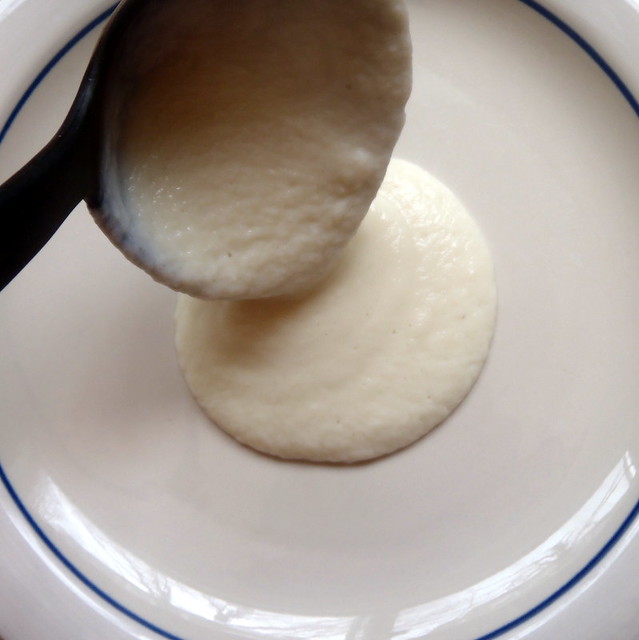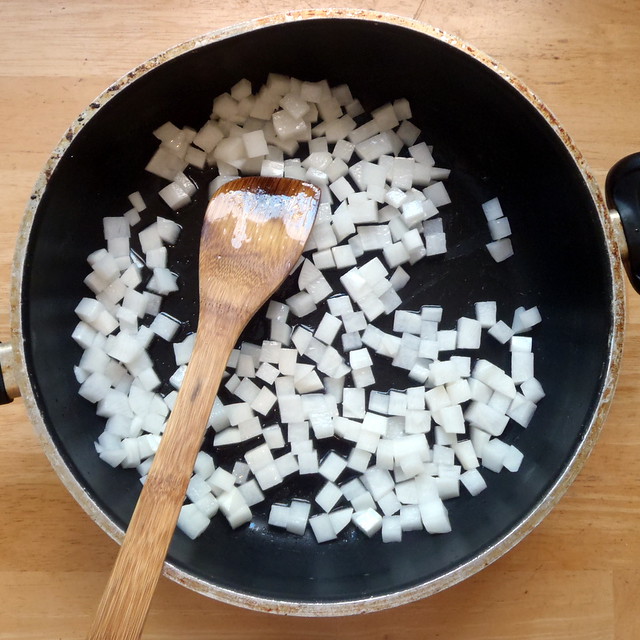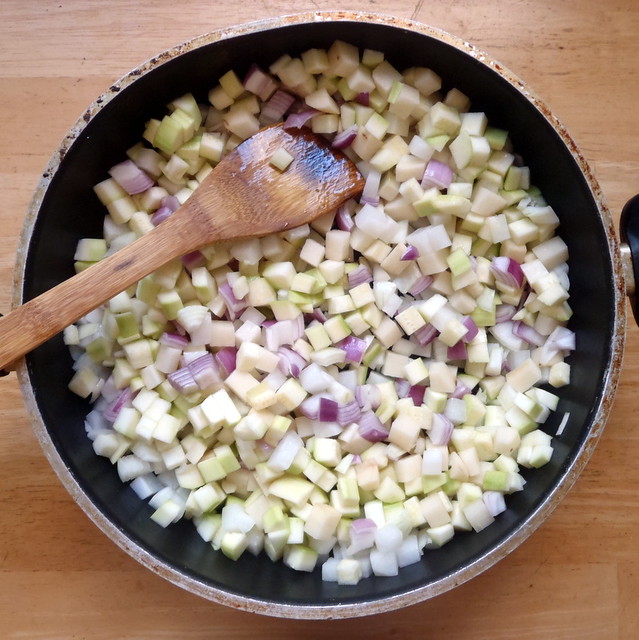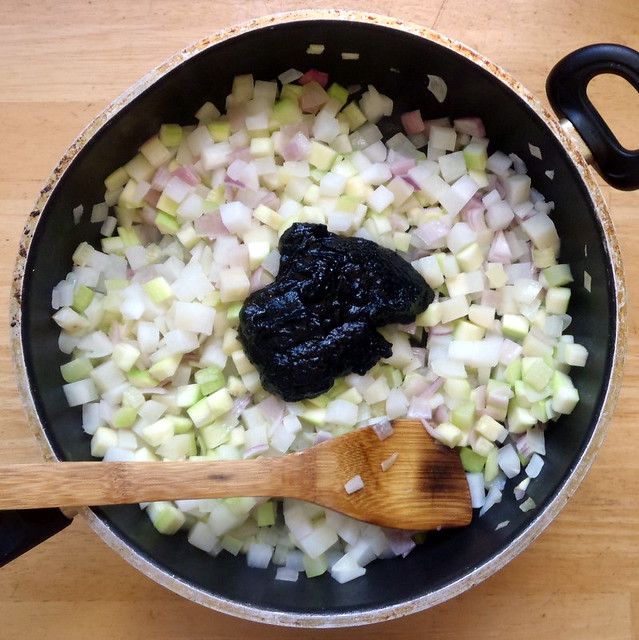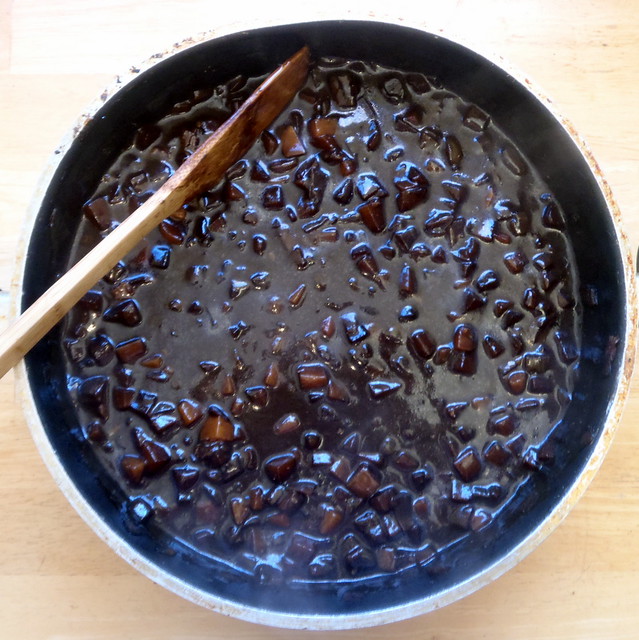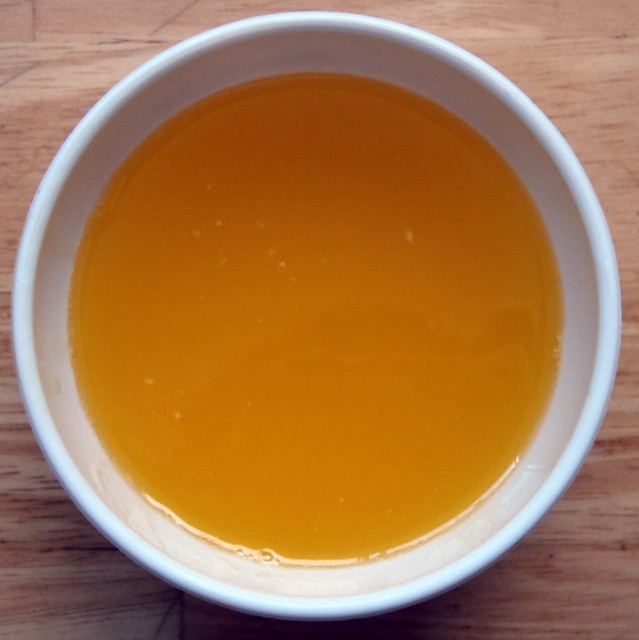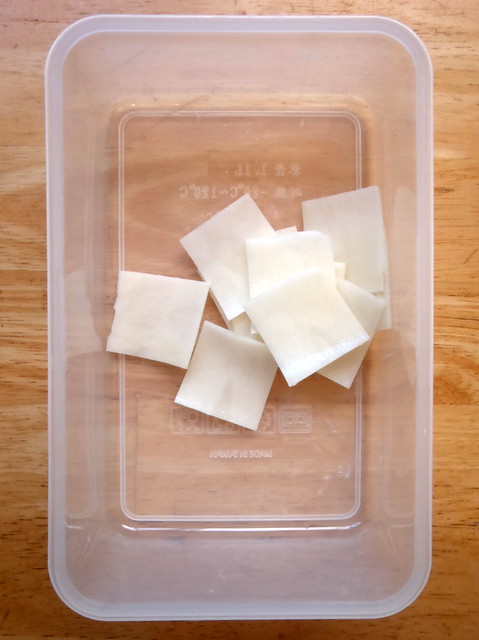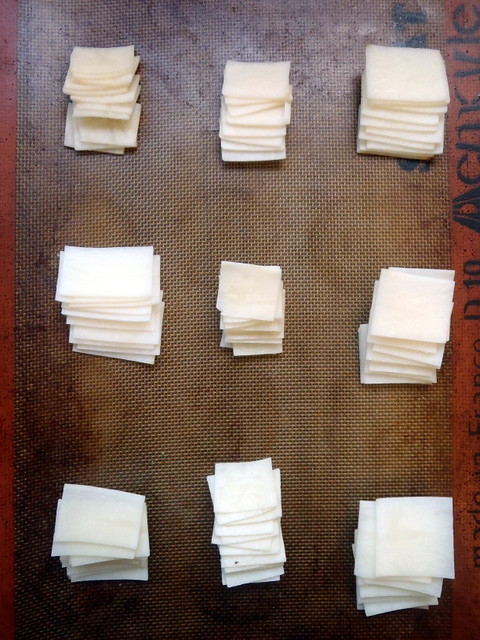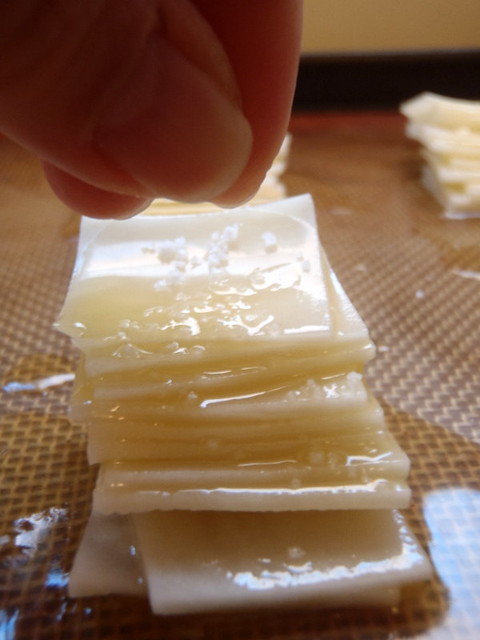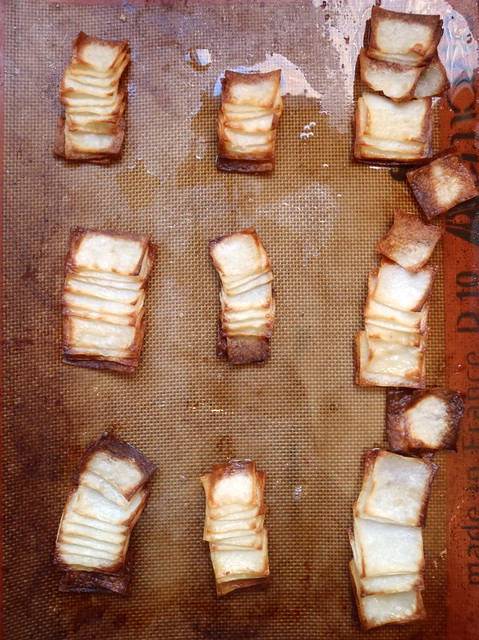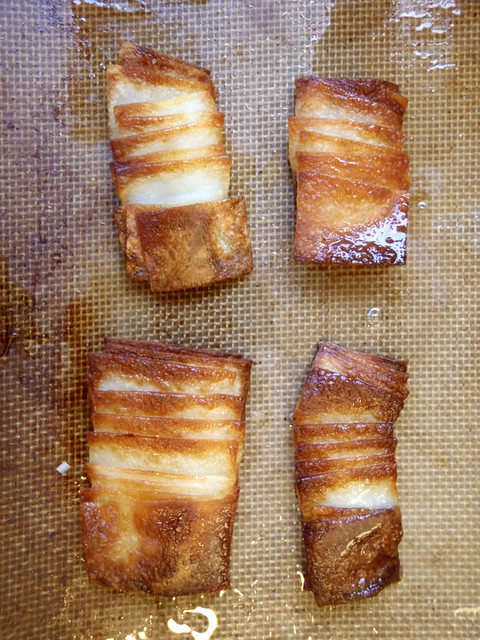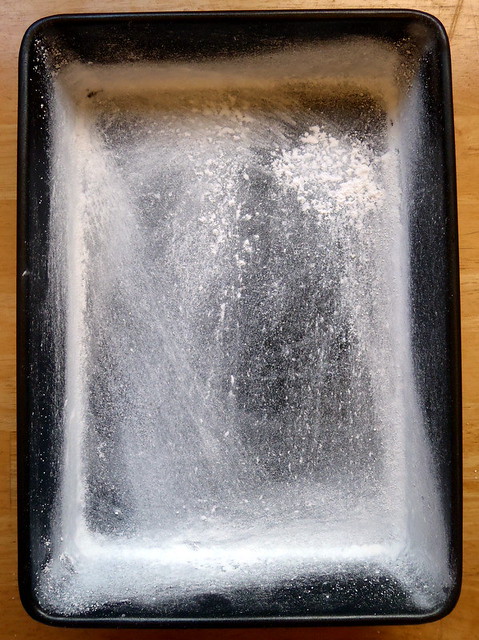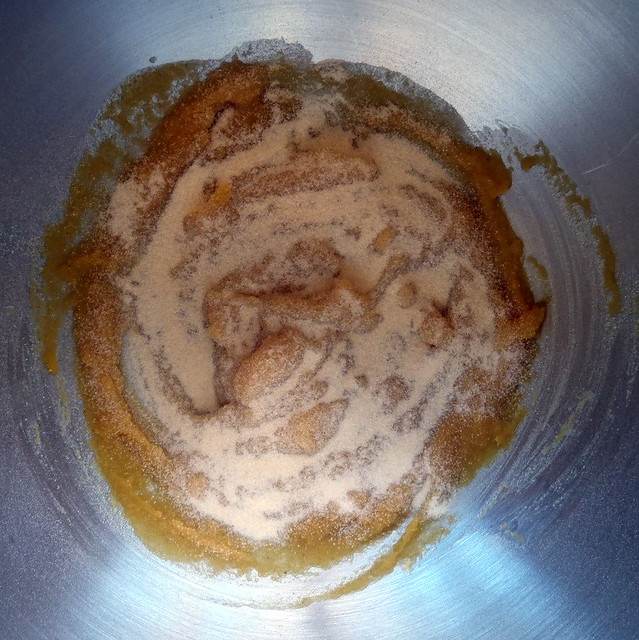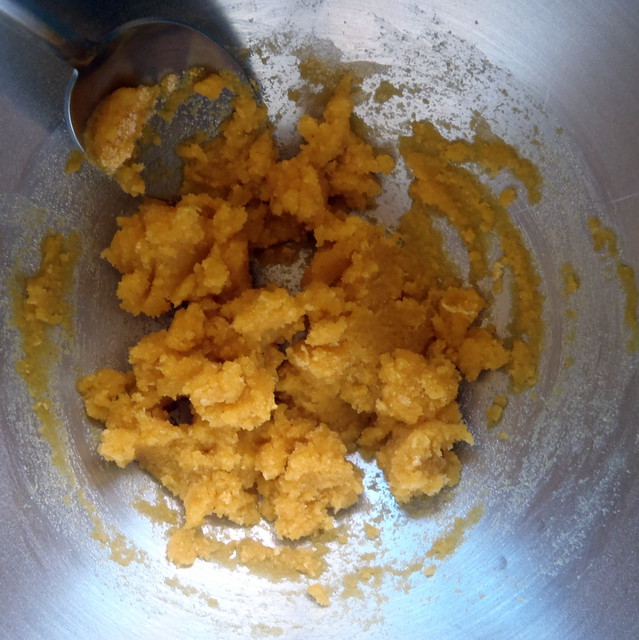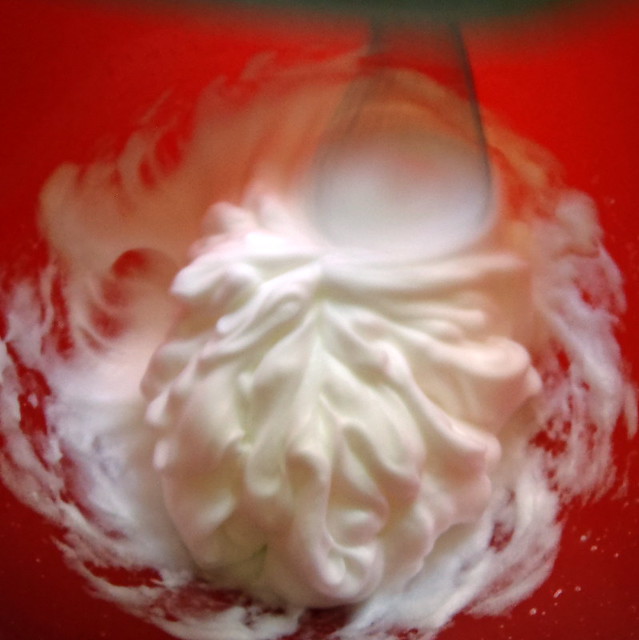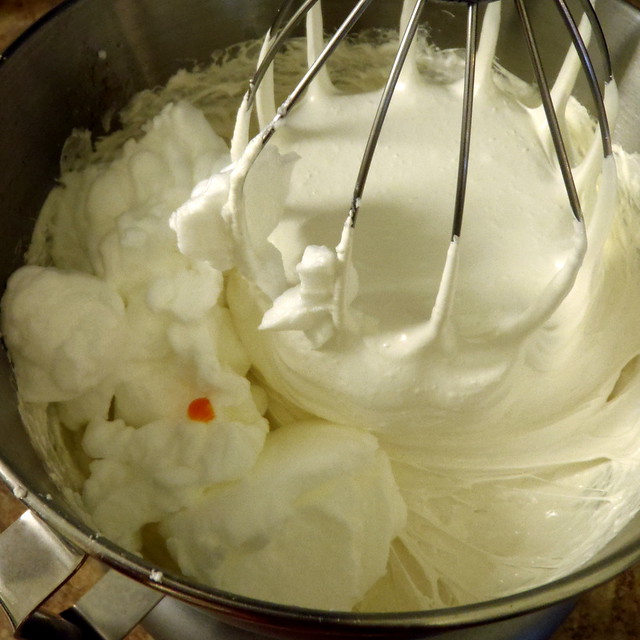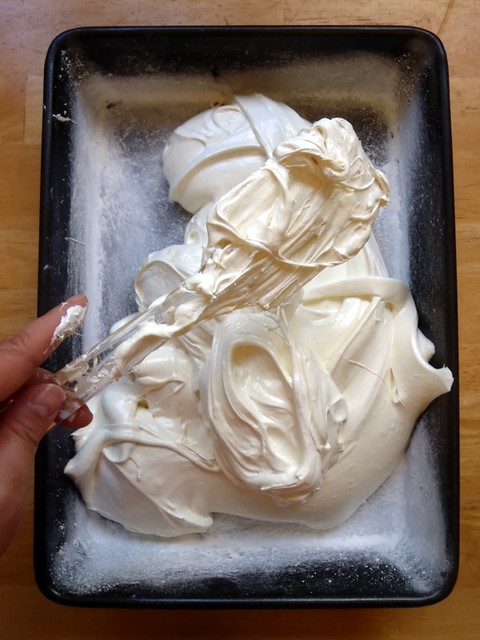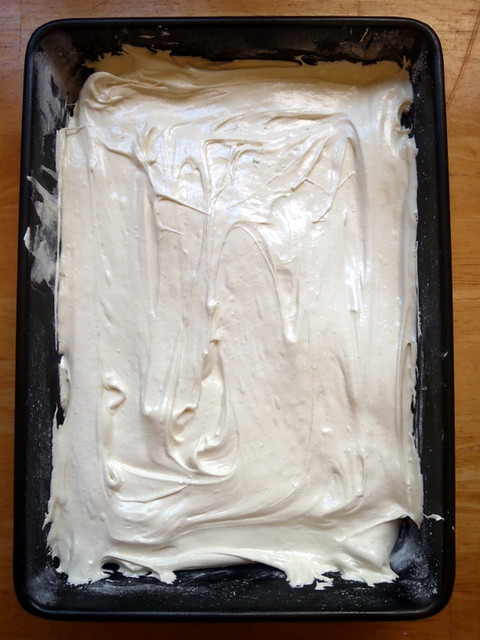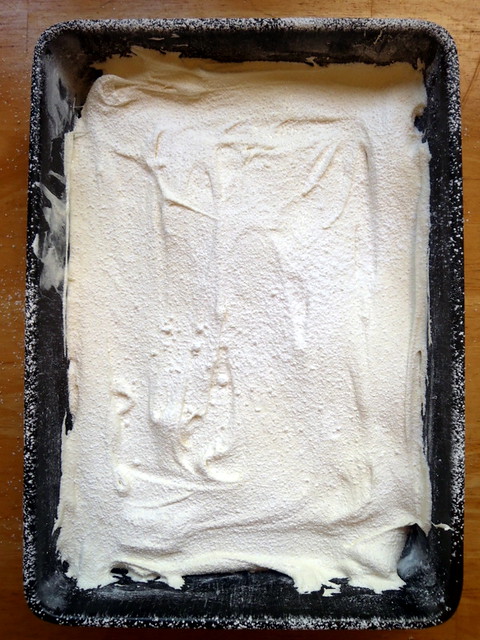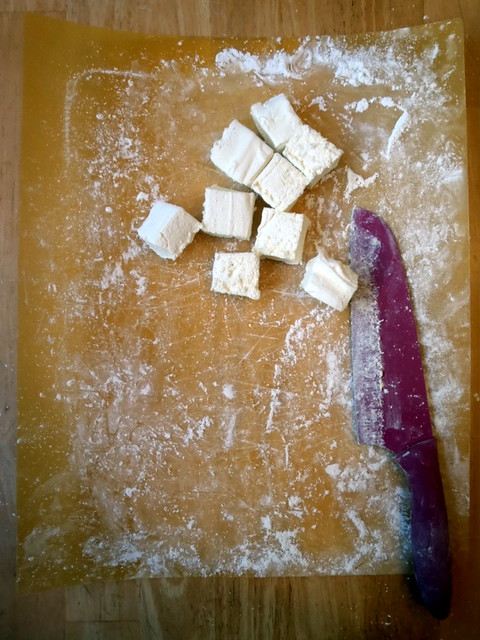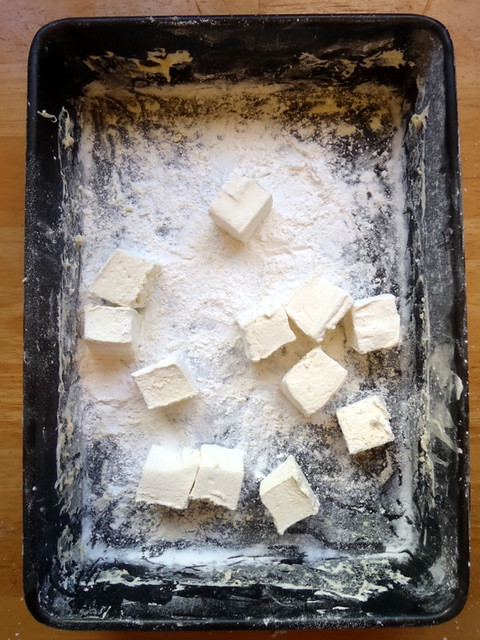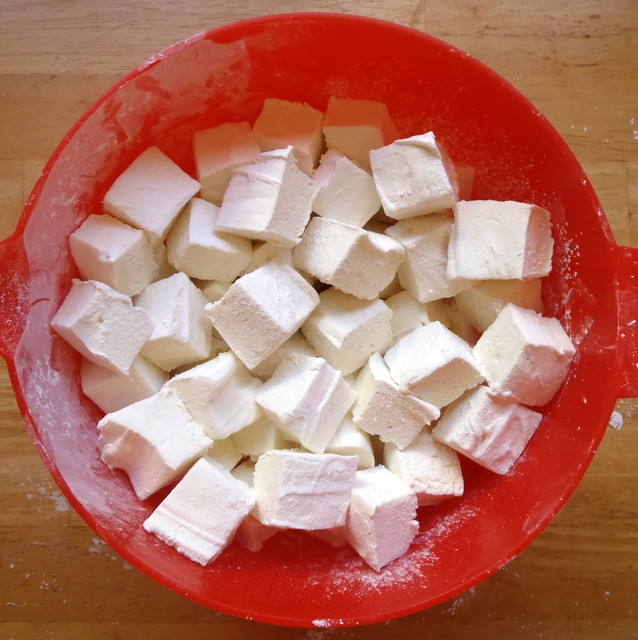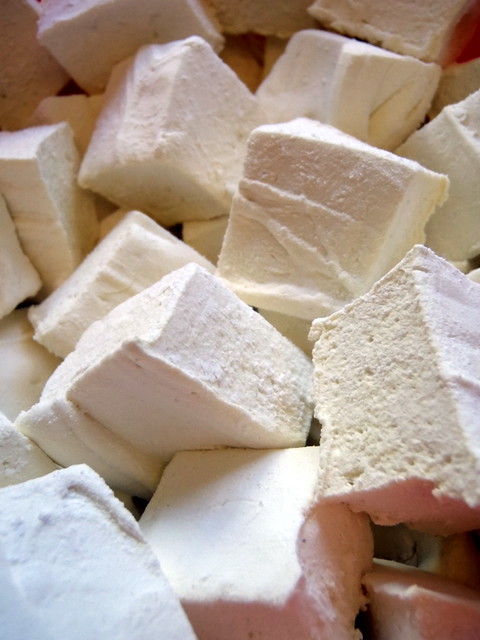I had gotten a bunch of kale and 2 sweet potatoes in my Boston Organics delivery and decided I wanted to make a soup out of them. After a quick search on-line, I found this recipe by Joy the Baker. I just happened to already have all the other ingredients on hand, too, so I think it was meant to be.
This soup is perfect on a cold, dreary night with it's super colorful vegetables and warm, spicy broth. Served over a bed of brown rice, it can be a meal all on its own, too.
Kale and Sweet Potato Soup (adapted from Joy the Baker)
serves 4-6
2 tablespoons olive oil
1 medium onion, diced
2 cloves garlic, chopped fine
1/2 teaspoon powdered ginger
3/4 teaspoon turmeric
1/4 teaspoon crushed red peppers (optional)
1 bunch kale, tough stems removed and roughly chopped
2 large sweet potatoes, peeled and diced into 1/2-inch cubes
1 1/2 quart chicken or vegetable broth
1 teaspoon kosher salt
Fresh ground pepper, to taste
1 can coconut milk
2 cups cooked brown rice
In a large saucepan, heat the olive oil over medium heat. Add the onions and cook down until tender and translucent, about five minutes. Add the garlic, ginger, turmeric, and crushed red pepper flakes, if using. Cook, stirring, for about 1 minute.
Add the sweet potato chunks and stir. Add the chicken or vegetable broth and bring to a simmer.
Add the kale once the broth is simmering and submerge all of the leaves, helping them to cook down. Cook for about 20 minutes, or until the sweet potatoes have become tender. Add salt and pepper to taste.
Lastly, stir in coconut milk and heat through. Serve over a bed of brown rice.
The soup freezes well, and I found the best way to cool it down quickly was to stick the pot straight in the snow.
Next: Peking Duck Pizza
Previously: Cauliflower Steak with Cauliflower Purée
Three years ago: Bacon Caramel Corn
Four years ago: Wok-Fried Edamame with Garlic, Panna Cotta, Take 1
Wednesday, February 27, 2013
Thursday, February 21, 2013
Cauliflower Steak with Cauliflower Purée
On the other side of the spectrum from the previous post, I knew I had to try making Dan Barber's Cauliflower Steak with Cauliflower Purée as soon as I saw it on Food52. I've always liked cauliflower but never gotten it in any Boston Organics deliveries. Seeing this recipe made me decide to stop waiting and go out and buy some (and luckily, cauliflower's on sale at Trader Joe's at the moment).
I knew the name Dan Barber sounded familiar to me, but I couldn't quite figure out how I had heard of him until I remembered that his TED talk on foie gras was the first TED talk I ever watched! I've also watched his TED talk on fish, and I would highly suggest watching them both. I don't know; there's just something about the way he talks--it's simple but also so very sincere. You won't regret it.
Anyways, back to this dish, which is really all about the cauliflower. You can get two nice, inch-thick "steaks" out of a head of cauliflower, which are then caramelized on a hot pan. The rest of the florets are cooked in milk and water and then puréed in a blender. Even though there's a bare minimum of ingredients, the two different cooking techniques make a pretty big difference in the taste of the two preparations of cauliflower. Plus, it looks really cool plated!
I decided to finish the dish with a sprinkle of truffle salt--not enough to overpower the delicate cauliflower flavor, but just enough to keep it out of the boring territory.
Cauliflower Steak with Cauliflower Purée (adapted from Food52)
serves 2
One 1 1/2 lb. head of cauliflower
1 1/2 cups water
1 cup milk
2 tablespoons oil plus more for brushing
Salt and freshly ground pepper
Truffle salt (optional)
Heat oven to 350°F. Using sharp heavy knife and starting at top center of cauliflower head, cut two 1-inch-thick slices of cauliflower, cutting through stem end. Set cauliflower steaks aside.
Cut enough florets from remaining cauliflower head to measure 3 cups. Combine florets, water, and milk in medium saucepan, and sprinkle with salt and pepper. Bring to boil and cook until cauliflower florets are very tender, about 10 minutes. Strain, reserving 1 cup cooking liquid.
Transfer florets to blender. Add half of the reserved 1 cup cooking liquid and purée until smooth. Add more of the liquid if desired, and purée again. Return purée to same saucepan.
Heat 2 tablespoons vegetable oil in heavy large ovenproof skillet over medium-high heat. Brush cauliflower steaks with additional oil and sprinkle with salt and pepper.
Add cauliflower steaks to skillet and cook until golden brown, about 2 minutes per side. Cover the pan with a splatter screen, if you have one. Transfer skillet to oven and bake cauliflower steaks until tender, about 10 minutes.
Rewarm cauliflower purée over medium heat. Divide purée between two plates; top each with cauliflower steak. Sprinkle a pinch of truffle salt on top and serve.
Personally, I would have liked a little more acid in the dish; maybe a reduction of balsamic vinegar drizzled over the top. It would make a nice striking contrast against all the white, too!
Next: Kale and Sweet Potato Soup
Previously: Jjajungmyeon (Korean Black Bean Noodles)
Three years ago: Faux Momofuku Brussels Sprouts
Four years ago: Boston Cream Cupcakes, One Avocado Ice Cream
I knew the name Dan Barber sounded familiar to me, but I couldn't quite figure out how I had heard of him until I remembered that his TED talk on foie gras was the first TED talk I ever watched! I've also watched his TED talk on fish, and I would highly suggest watching them both. I don't know; there's just something about the way he talks--it's simple but also so very sincere. You won't regret it.
Anyways, back to this dish, which is really all about the cauliflower. You can get two nice, inch-thick "steaks" out of a head of cauliflower, which are then caramelized on a hot pan. The rest of the florets are cooked in milk and water and then puréed in a blender. Even though there's a bare minimum of ingredients, the two different cooking techniques make a pretty big difference in the taste of the two preparations of cauliflower. Plus, it looks really cool plated!
I decided to finish the dish with a sprinkle of truffle salt--not enough to overpower the delicate cauliflower flavor, but just enough to keep it out of the boring territory.
Cauliflower Steak with Cauliflower Purée (adapted from Food52)
serves 2
One 1 1/2 lb. head of cauliflower
1 1/2 cups water
1 cup milk
2 tablespoons oil plus more for brushing
Salt and freshly ground pepper
Truffle salt (optional)
Heat oven to 350°F. Using sharp heavy knife and starting at top center of cauliflower head, cut two 1-inch-thick slices of cauliflower, cutting through stem end. Set cauliflower steaks aside.
Cut enough florets from remaining cauliflower head to measure 3 cups. Combine florets, water, and milk in medium saucepan, and sprinkle with salt and pepper. Bring to boil and cook until cauliflower florets are very tender, about 10 minutes. Strain, reserving 1 cup cooking liquid.
Transfer florets to blender. Add half of the reserved 1 cup cooking liquid and purée until smooth. Add more of the liquid if desired, and purée again. Return purée to same saucepan.
Heat 2 tablespoons vegetable oil in heavy large ovenproof skillet over medium-high heat. Brush cauliflower steaks with additional oil and sprinkle with salt and pepper.
Add cauliflower steaks to skillet and cook until golden brown, about 2 minutes per side. Cover the pan with a splatter screen, if you have one. Transfer skillet to oven and bake cauliflower steaks until tender, about 10 minutes.
Rewarm cauliflower purée over medium heat. Divide purée between two plates; top each with cauliflower steak. Sprinkle a pinch of truffle salt on top and serve.
Personally, I would have liked a little more acid in the dish; maybe a reduction of balsamic vinegar drizzled over the top. It would make a nice striking contrast against all the white, too!
Next: Kale and Sweet Potato Soup
Previously: Jjajungmyeon (Korean Black Bean Noodles)
Three years ago: Faux Momofuku Brussels Sprouts
Four years ago: Boston Cream Cupcakes, One Avocado Ice Cream
Monday, February 18, 2013
Jjajungmyeon (Korean Black Bean Noodles)
Apparently, Valentine's Day is celebrated by singles in South Korea by getting together and eating jjajungmyeon. I asked a Korean friend about this tradition, and he said that it's because, like spaghetti, it's one of those dishes that you don't want to eat on a date because it can get really messy. Good enough for me.
When I found out that some of my friends were going to go to a Korean restaurant to eat this last Thursday, I was like, you know it's really easy to make at home, right? Which somehow turned into me making a last minute Asian grocery store run and hosting 4 single guys on Valentine's Day. Sigh.
That same Korean friend pointed me to this recipe saying that it's pretty authentic except that he fries the sauce separately from the rest of the ingredients and then adds it in. Which I guess is where the name of the dish comes from; it literally translates to "fried sauce noodles". There's a Chinese version of this dish too, but it uses a soybean paste versus the black bean paste that's used in the Korean version.
The traditional noodles used for this dish are flat white wheat noodles, similar in shape to fettuccine. If you can't find them, you can try substituting with fettuccine, but you'll want to cook the noodles past al dente so that they're pretty soft (but not falling apart).
Jjajungmyeon (adapted from Maangchi)
serves 6
4 tablespoons vegetable oil, divided
1 medium daikon radish, diced into 1 cm cubes (about 2 cups worth)
2 medium zucchinis, diced into 1 cm cubes (about 2 cups worth)
2 medium potatoes, diced into 1 cm cubes (about 2 cups worth)
4 small onions, chopped
Heaping 1/2 cup of jjajung (Korean fermented black bean paste)
2 tablespoons corn starch
2 teaspoons sugar
2 teaspoons sesame oil
Jjajungmyeon noodles, cooked
Heat a large pan on medium-high heat and add 2 tablespoons of vegetable oil. Once the oil is hot, add the cubed daikon and stir fry for about a minute.
Add the diced zucchini, potato, and onions and stir fry until the potato is translucent, about 5 minutes.
In the meantime, in a small sauce pan, heat the remaining 2 tablespoons of oil. Add the jjajung and stir fry for about a minute.
Add the fried sauce to the vegetables and add four cups of water. Once the sauce is boiling, lower the heat, cover the pan, and cook until the vegetables are cooked through, about 10 minutes.
Mix the cornstarch and sugar in 1/4 cup of water. Add to the sauce and stir until it thickens. Add the sesame oil and mix.
Portion out the cooked noodles into large bowls. Top with the sauce and mix well.
I think the best part about this dish is how cheap it is; I spent less than $15 to feed all five of us, plus I had enough leftovers for one more meal!
Next: Cauliflower Steak with Cauliflower Purée
Previously: Potato Dominoes
Three years ago: Nutella Ice Cream
Four years ago: New England Clam Chowda and Homemade Oyster Crackers
When I found out that some of my friends were going to go to a Korean restaurant to eat this last Thursday, I was like, you know it's really easy to make at home, right? Which somehow turned into me making a last minute Asian grocery store run and hosting 4 single guys on Valentine's Day. Sigh.
That same Korean friend pointed me to this recipe saying that it's pretty authentic except that he fries the sauce separately from the rest of the ingredients and then adds it in. Which I guess is where the name of the dish comes from; it literally translates to "fried sauce noodles". There's a Chinese version of this dish too, but it uses a soybean paste versus the black bean paste that's used in the Korean version.
The traditional noodles used for this dish are flat white wheat noodles, similar in shape to fettuccine. If you can't find them, you can try substituting with fettuccine, but you'll want to cook the noodles past al dente so that they're pretty soft (but not falling apart).
Jjajungmyeon (adapted from Maangchi)
serves 6
4 tablespoons vegetable oil, divided
1 medium daikon radish, diced into 1 cm cubes (about 2 cups worth)
2 medium zucchinis, diced into 1 cm cubes (about 2 cups worth)
2 medium potatoes, diced into 1 cm cubes (about 2 cups worth)
4 small onions, chopped
Heaping 1/2 cup of jjajung (Korean fermented black bean paste)
2 tablespoons corn starch
2 teaspoons sugar
2 teaspoons sesame oil
Jjajungmyeon noodles, cooked
Heat a large pan on medium-high heat and add 2 tablespoons of vegetable oil. Once the oil is hot, add the cubed daikon and stir fry for about a minute.
Add the diced zucchini, potato, and onions and stir fry until the potato is translucent, about 5 minutes.
In the meantime, in a small sauce pan, heat the remaining 2 tablespoons of oil. Add the jjajung and stir fry for about a minute.
Add the fried sauce to the vegetables and add four cups of water. Once the sauce is boiling, lower the heat, cover the pan, and cook until the vegetables are cooked through, about 10 minutes.
Mix the cornstarch and sugar in 1/4 cup of water. Add to the sauce and stir until it thickens. Add the sesame oil and mix.
Portion out the cooked noodles into large bowls. Top with the sauce and mix well.
I think the best part about this dish is how cheap it is; I spent less than $15 to feed all five of us, plus I had enough leftovers for one more meal!
Next: Cauliflower Steak with Cauliflower Purée
Previously: Potato Dominoes
Three years ago: Nutella Ice Cream
Four years ago: New England Clam Chowda and Homemade Oyster Crackers
Wednesday, February 13, 2013
Potato Dominoes
I've made potatoes french fried, hashed, crashed, mashed on a pizza, and even mashed in a St. Patrick's Day maki roll, but never have I ever heard of making them dominoed before. Then all within the span of one day, I read two separate posts about Francis Mallmann's Potato Dominoes. Coincidence? I think not.
They're basically potatoes cut into rectangular blocks, then sliced thinly into something like a deck of cards. Then they're roasted with clarified butter and some salt. That's it!
The great thing about making potatoes this way is that it totally works for potatoes that may have been sitting around a little too long. You know the ones I'm talking about--the ones that have little (or maybe not so little) growths in the eyes--the same ones that you may just throw away in a couple of days. The genius of this recipe is that in order to get the potatoes into that block shape, you end up cutting off a lot of the outside. While with normal potatoes this would seem like a waste (although you could always save them to make oven fries or loaded potato skins), with the old, squidgy potatoes, you'd be cutting all that off anyways!
Potato Dominoes (adapted from Seven Fires: Grilling the Argentine Way)
serves 1-2
1/4 cup unsalted butter
1 lb. potatoes
Coarse salt
Make clarified butter by slowly melting the butter in a small heavy saucepan over medium-low heat; do not stir.
Remove from the heat and carefully spoon off any foam from the top.
Carefully pour the clear liquid butter into a small container, leaving behind the solids in the pan. Once cool, the clarified butter can be refrigerated for weeks.
Preheat oven (with the rack positioned in the center of the oven) to 400°F. Line a rimmed baking sheet with a Silpat.
Cut off the two ends of a potato. Trim the 4 sides of the potato to form an even brick.
Slice the potato about 1/8 inch thick on a mandoline.
Stack the slices together like a deck of cards. Tilt the stack over at an angle and lay on the prepared baking sheet. Dot the top and sides with 1 tablespoon of the clarified butter.
Sprinkle with salt to taste. Repeat with the remaining potatoes, keeping the stacks at least 2 inches apart.
Bake for 40 minutes or until the potatoes are browned on the edges and tender in the middle when tested with a skewer. Serve immediately.
At first I couldn't understand how Food52 got their potato dominoes to look so browned but then I realized they just flipped them over!
These turned out exactly as promised: crispy at the edges and yet somehow still creamy in the middle. I loved that each slice was cooked through; I really hate the taste and texture of undercooked potato. I'd love to try this with maybe a sprig of rosemary or thyme laid across the top of each stack or maybe even with duck fat instead of the butter.
Next: Jjajungmyeon (Korean Black Bean Noodles)
Previously: Passion Fruit Marshmallows
Four years ago: Tomato and Eggs over Rice, Cassava Heavy Cake
They're basically potatoes cut into rectangular blocks, then sliced thinly into something like a deck of cards. Then they're roasted with clarified butter and some salt. That's it!
The great thing about making potatoes this way is that it totally works for potatoes that may have been sitting around a little too long. You know the ones I'm talking about--the ones that have little (or maybe not so little) growths in the eyes--the same ones that you may just throw away in a couple of days. The genius of this recipe is that in order to get the potatoes into that block shape, you end up cutting off a lot of the outside. While with normal potatoes this would seem like a waste (although you could always save them to make oven fries or loaded potato skins), with the old, squidgy potatoes, you'd be cutting all that off anyways!
Potato Dominoes (adapted from Seven Fires: Grilling the Argentine Way)
serves 1-2
1/4 cup unsalted butter
1 lb. potatoes
Coarse salt
Make clarified butter by slowly melting the butter in a small heavy saucepan over medium-low heat; do not stir.
Remove from the heat and carefully spoon off any foam from the top.
Carefully pour the clear liquid butter into a small container, leaving behind the solids in the pan. Once cool, the clarified butter can be refrigerated for weeks.
Preheat oven (with the rack positioned in the center of the oven) to 400°F. Line a rimmed baking sheet with a Silpat.
Cut off the two ends of a potato. Trim the 4 sides of the potato to form an even brick.
Slice the potato about 1/8 inch thick on a mandoline.
Stack the slices together like a deck of cards. Tilt the stack over at an angle and lay on the prepared baking sheet. Dot the top and sides with 1 tablespoon of the clarified butter.
Sprinkle with salt to taste. Repeat with the remaining potatoes, keeping the stacks at least 2 inches apart.
Bake for 40 minutes or until the potatoes are browned on the edges and tender in the middle when tested with a skewer. Serve immediately.
At first I couldn't understand how Food52 got their potato dominoes to look so browned but then I realized they just flipped them over!
These turned out exactly as promised: crispy at the edges and yet somehow still creamy in the middle. I loved that each slice was cooked through; I really hate the taste and texture of undercooked potato. I'd love to try this with maybe a sprig of rosemary or thyme laid across the top of each stack or maybe even with duck fat instead of the butter.
Next: Jjajungmyeon (Korean Black Bean Noodles)
Previously: Passion Fruit Marshmallows
Four years ago: Tomato and Eggs over Rice, Cassava Heavy Cake
Wednesday, February 6, 2013
Passion Fruit Marshmallows
Just like I did with Smitten Kitchen's caramels, I wanted to try to make her marshmallows with my own personal favorite flavor: passion fruit! It turned out to be incredibly easy; I just substituted the 1/2 cup of water that you dissolve the gelatin in with a 1/2 cup of passion fruit puree!
Passion Fruit Marshmallows
Makes about 96 1-inch cubed marshmallows
About 1 cup confectioners sugar
3 1/2 envelopes (2 tablespoons plus 2 1/2 teaspoons) unflavored gelatin
1/2 cup passion fruit puree, thawed but cold
1/2 cup cold water
2 cups sugar
1/2 cup light corn syrup
1/4 teaspoon salt
2 large egg whites, at room temperature
Yellow gel food coloring (optional)
Oil bottom and sides of a 13- by 9- by 2-inch rectangular metal baking pan and dust bottom and sides with some confectioners sugar.
In bowl of a standing electric mixer sprinkle gelatin over 1/2 cup cold passion fruit puree and let stand to soften.
If all the gelatin does not dissolve, gently combine with a spoon so that none of the gelatin powder is left dry.
In a 3-quart heavy saucepan cook granulated sugar, corn syrup, 1/2 cup of cold water, and salt over low heat, stirring with a wooden spoon, until sugar is dissolved. Increase heat to moderate and boil mixture, without stirring, until a candy or digital thermometer registers 240°F, about 12 minutes. Remove pan from heat and pour sugar mixture over gelatin mixture, stirring until gelatin is dissolved.
With standing mixer beat mixture on high speed until white, thick, and nearly tripled in volume, about six minutes.
In separate medium bowl with cleaned beaters beat egg whites until they just hold stiff peaks.
Beat whites into sugar mixture until just combined. At this point, if you would like to color your marshmallows, you can add a few drops of yellow food coloring. This also helps let you know when the egg whites have been fully combined in the mixture. (I only added 1 drop, and you can barely tell in these pictures that the marshmallows aren't white.)
Pour mixture into baking pan. This is probably the trickiest part of the whole operation.
Try to smooth out the marshmallow fluff as best you can. I take it back; this is the trickiest part. It's okay if you don't get it perfectly smooth because then it's super obvious that it's homemade!
Sift 1/4 cup confectioners sugar evenly over top.
Chill marshmallow, uncovered, until firm, at least three hours, and up to one day.
Run a thin knife around edges of pan and invert pan onto a large cutting board. Lifting up one corner of inverted pan, with fingers loosen marshmallow and ease onto cutting board. With a large knife cut marshmallow into roughly one-inch cubes.
Sift remaining confectioners’ sugar back into your now-empty baking pan, and working in batches, roll the marshmallows through it, on all six sides, before shaking off the excess and packing them away.
Marshmallows keep in an airtight container at cool room temperature 1 week.
These marshmallows were all that I hoped they would be: soft and bouncy and tart and sweet. They taste like pure sunshine to me. If I had an experience with a Dementor, I'd eat one of these afterwards, and it would make me feel better than chocolate could. ^_^
Next: Potato Dominoes
Previously: Vanilla Cinnamon Marshmallows
Three years ago: Lemon Pudding Cake
Passion Fruit Marshmallows
Makes about 96 1-inch cubed marshmallows
About 1 cup confectioners sugar
3 1/2 envelopes (2 tablespoons plus 2 1/2 teaspoons) unflavored gelatin
1/2 cup passion fruit puree, thawed but cold
1/2 cup cold water
2 cups sugar
1/2 cup light corn syrup
1/4 teaspoon salt
2 large egg whites, at room temperature
Yellow gel food coloring (optional)
Oil bottom and sides of a 13- by 9- by 2-inch rectangular metal baking pan and dust bottom and sides with some confectioners sugar.
In bowl of a standing electric mixer sprinkle gelatin over 1/2 cup cold passion fruit puree and let stand to soften.
If all the gelatin does not dissolve, gently combine with a spoon so that none of the gelatin powder is left dry.
In a 3-quart heavy saucepan cook granulated sugar, corn syrup, 1/2 cup of cold water, and salt over low heat, stirring with a wooden spoon, until sugar is dissolved. Increase heat to moderate and boil mixture, without stirring, until a candy or digital thermometer registers 240°F, about 12 minutes. Remove pan from heat and pour sugar mixture over gelatin mixture, stirring until gelatin is dissolved.
With standing mixer beat mixture on high speed until white, thick, and nearly tripled in volume, about six minutes.
In separate medium bowl with cleaned beaters beat egg whites until they just hold stiff peaks.
Beat whites into sugar mixture until just combined. At this point, if you would like to color your marshmallows, you can add a few drops of yellow food coloring. This also helps let you know when the egg whites have been fully combined in the mixture. (I only added 1 drop, and you can barely tell in these pictures that the marshmallows aren't white.)
Pour mixture into baking pan. This is probably the trickiest part of the whole operation.
Try to smooth out the marshmallow fluff as best you can. I take it back; this is the trickiest part. It's okay if you don't get it perfectly smooth because then it's super obvious that it's homemade!
Sift 1/4 cup confectioners sugar evenly over top.
Chill marshmallow, uncovered, until firm, at least three hours, and up to one day.
Run a thin knife around edges of pan and invert pan onto a large cutting board. Lifting up one corner of inverted pan, with fingers loosen marshmallow and ease onto cutting board. With a large knife cut marshmallow into roughly one-inch cubes.
Sift remaining confectioners’ sugar back into your now-empty baking pan, and working in batches, roll the marshmallows through it, on all six sides, before shaking off the excess and packing them away.
Marshmallows keep in an airtight container at cool room temperature 1 week.
These marshmallows were all that I hoped they would be: soft and bouncy and tart and sweet. They taste like pure sunshine to me. If I had an experience with a Dementor, I'd eat one of these afterwards, and it would make me feel better than chocolate could. ^_^
Next: Potato Dominoes
Previously: Vanilla Cinnamon Marshmallows
Three years ago: Lemon Pudding Cake
Subscribe to:
Comments (Atom)
